Cette publication est également disponible en :
Français
In many ways, leather and perfumery have a similar history, always closely linked. Leather gloves have been perfumed since ancient times, although the profession of master glover-perfumer was not given formal status until much later. At the heart of the great perfumery classics, the leather accord is now making a strong comeback. Christine Nagel, in-house perfumer at Hermès, and Céline Perdriel, perfumer at Cosmo, take a closer look.
Intertwined origins
Just as perfume has historically been overlooked by archaeologists because it evaporates and is therefore apparently invisible[1] See the article on this subject in Nez #15 – As time goes by., leather, rarely found on excavation sites because it decays, has remained in the shadows of the ancient history of crafts. Aside from the rare fragments found during archaeological investigations, traces of its processing are the only element open to study – although with one caveat noted by researcher Sylvie Beyries: “Leatherworking is an activity that leaves very few remains on the ground. Tools are often the only evidence of this craft.”[2]Beyries S. 2008. “Modélisation du travail du cuir en ethnologie : proposition d’un système ouvert à l’archéologie [Modelling leatherworking in ethnology: proposal for a system open to … Continue reading
It is generally accepted that its use developed with the consumption of meat in the Neanderthal period in the form of a useful by-product for clothing. The transformation process, which produces supple and, above all, rot-proof leather, involves various operations: fleshing, dehairing, drying and, above all, tanning. Vegetable tannins derived from tree bark or leaves have long been used in the tanning process, and still form the basis of what is known as “vegetable tanning”. But by far the most common process, accounting for around 80% of world production, is chrome sulphate tanning, which emerged with the beginnings of organic chemistry in the 1880s – the same decade that saw the birth of modern perfumery. But leatherworking does not stop there. In the 16th century, on the Iberian Peninsula, leather was perfumed with essences of herbs and flowers, civet and musk: this was the famous “peau d’Espagne” (skin of Spain), used in particular for gloves. Already present in antiquity, it is often said to have been introduced to Grasse by Catherine de Médicis, but “this early link between perfumery and the Provençal town nevertheless appears to be anachronistic,” points out the historian Mathilde Cocoual. “The town of Grasse has had two guilds of tanners since the 12th century who use local perfume plants – mainly myrtle – to tone down the smell of leather. However, it wasn’t until the late 17th century that several Grasse residents began making luxury gloves.”[3]Mathilde Cocoual, Aux sources des parfums. Industrialisation et approvisionnement de la parfumerie grassoise (milieu XIXe–milieu XXe siècle) [The source of perfumes. Industrialisation and sourcing … Continue readingThe privileges of master glover-perfumers, acknowledged and championed by Henri III in 1582 then by Louis XIV in 1656, led to official recognition of the guild by the Parliament of Aix-en-Provence in 1729. At the time, Grasse had an international reputation for its expertise in both leather and perfume. But in 1759, crises in the leather industry led to the separation of the guild of master perfumers from that of glove-makers, and the people of Grasse began to specialise in perfumery and soap-making, before abandoning soaps to concentrate on scents.
A variety of leathers
However, we can apply ourselves to the task of characterising the scent of leather: “It gives off notes of smoke, tobacco; sensual, warm, animal notes, dry notes with character”, explains Christine Nagel. The smell of leather – and the name we give it – can differ greatly depending on the origin of the hide (nearly all from cows, goats, sheep and buffalo, in addition to the rare “exotic leathers”), the part used and its treatment: from peau d’Espagne to Russian leather – characterised by its treatment with birch bark, making it resistant to mould for use in waterproofing Russian soldiers’ boots – and suede, the other name for doeskin, which refers to a velvety leather produced by working the inside of the hide. As the perfumer explains: “When it comes to leather, I’m constantly capturing more nuances:, it feels like they’re never-ending. The treasures of our leather cellar, that secret, fragrant place where the heart of Hermès beats, open the door to endless discoveries, since the collections are so beautiful, varied and colourful. You can listen to the leather, the leathers, breathe. And the skins with all their diversity of texture, touch and breath can become a direct source of inspiration for creations, as was the case for Galop and Violette Volynka. I also like to work with the tension, suppleness and structure of the leathers. They all pique my curiosity and interest.”
Further proof of the olfactory diversity of this material is provided by the testimonies of people who work with it in “The nose of leather”, an article featured in Nez, the Olfactory Magazine 15 – As time goes by.
From material to fragrance: the leathery palette
When it comes to bringing out the olfactory complexity of leather, animalic materials seem an obvious choice. Musk and civet are now banned, but castoreum and ambergris can still be used today, albeit cautiously, as Céline Perdriel notes: “LVMH and Yves Rocher instigated the demand for ‘vegan’ perfumes. And there was also an IFRA recommendation that made it more complicated to use styrax, a resin that could reproduce the leathery note. When I was asked to reformulate a men’s classic from the 1980s, I had to deal with these constraints. It initially took me months to understand its twenty-five-level formula before I was able to look for solutions.” However, the perfumer has more than one trick up her sleeve: for example, she uses Africa stone – the petrified urine of a small mammal from Somalia – as well as turning to the plant kingdom, with certain facets blurring the olfactory distinction between animal and vegetable: cistus labdanum, oud and tobacco, in particular. “Labdanum, obtained by processing whole branches from which a resinoid is extracted, is drier; cistus absolute is more ambery and liqueur-like; the essence is very vertical, spicier and more animalic. And then there are all the variations: cracked cistus – which is heated – gives a more mineral, smoky product, closer to ambergris; hydrocarboresin is more aromatic. As for oud, there’s a clear difference between its classic version and the ‘boya’, its white part, which is very animalic, very cheesy.”
Chemists added fuel to the perfumers’ fire with the discovery of isobutyl quinoline (IBQ) in 1908. Designed to facilitate the use of synthetic molecules, it led to various composition houses creating bases – mixtures of synthetic and natural molecules – like Mousse de Saxe from De Laire (now acquired by Symrise): “Leather bases, such as Cuir de Russie, were also very important at Synarome, where I did my internship when I was studying at ISIPCA. For example, we had a leather obtained by heating a cistus fraction using a very long, secret process,” says Céline Perdriel. “When I was working with Rosendo Mateu at Puig on a project, he gave me a little lesson in leathers, categorising them into four types: smoked leather (from Russia), phenolic leather that smells of marker (styrax), IBQ leather (asparagus, vetiver), and violet leather characterised by beta ionone.”
Today, the field has expanded even further: “Lots of synthetic notes have leathery resonances and facets that I find interesting, such as Suedéral, Cashmeran and quinolines,” adds Christine Nagel.
Perfumery classics
The history of leather has always been a source of inspiration for perfumers. Leather-influenced creations include Cuir de Russie created by Aimé Guerlain in 1872, now discontinued, Peau d’Espagne released the same year by Oriza L. Legrand, now discontinued and reintroduced in 2022 in a reworked version (see below), and a creation of the same name by Santa Maria Novella in 1901, which still exists.
But it was Caron that changed the game in 1919: “Tabac blond really did inaugurate the leathery family, standing out from the traditional Spanish skin and Russian leather accords with powerful oriental and woody notes alongside spicy floral notes (carnation and ylang-ylang),” says Yohan Cervi in Une histoire de parfums.
A few years later, in 1924, it was Gabrielle Chanel’s turn: having befriended several Russian intellectuals who had fled the 1917 revolution, she launched her Cuir de Russie, where an aldehydic star jasmine sparkles against a backdrop of animality and the smokiness of birch tar. Ernest Beaux was responsible for this masterpiece, which will soon celebrate its hundredth birthday. Knize Ten was also released at this point, a powdery leather fragrance that has become a classic among perfumistas and is attributed to François Coty and Vincent Roubert.
We regret the disappearance of Lanvin’s magnificent Scandal, launched in 1933, both animalic and elegant; we invite you to discover it at the Osmothèque (the world’s only perfume archive based in Versailles, France).
It is interesting to note that, at the time, the leathery note was intended for a feminine audience, as opposed to the masculine category where mainstream perfumery most often classifies it today. In fact, a whole sub-family of leathery chypres emerged in the 1940s. The first slap in the face – the right expression to use for this overdose of IBQ – came from Germaine Cellier with Bandit by Piguet. A green leather, where oakmoss and patchouli give depth to the bouquet of dried flowers. The perfumer also created a leathery, elegantly animalic chypre with Jolie Madame by Balmain in 1953.
The more discreet but just as cult Cabochard from Grès in 1959 gave us Bernard Chant’s interpretation of chypre leather, where IBQ is rounded out with notes creating a more velvety, tender, powdery feel.
It wasn’t until quite some time later that leather became a masculine fragrance. It is hardly surprising that the leathery accord should feature in the first fragrance launched by the famous leather goods brand in 1951: unlike what its name suggests, behind its aromatic opening Eau d’Hermès reveals a cumin that Edmond Roudnitska had already used in Femme, and which here makes the link with the gently animalic, woody base. Jean-Louis Sieuzac explored a darker leather with Bel Ami in 1986, in a chypre, resinous and spicy ensemble.
Guerlain’s Habit rouge, launched in 1965, is an ode to horse riders’ clothes, a leather that is both citrusy and balsam-like – a worthy “little brother” for Shalimar – which has lost none of its majestic character and remains an icon of the genre.
And then there’s Polo by Ralph Lauren: a sometimes underestimated masterpiece offering a skilful interplay between the vegetation of lawns and the animality of the players’ sweat beading on saddle leather. As Alexis Toublanc describes it in Les 111 Parfums qu’il faut sentir avant de mourir, it “heralds the many explorations of the darker, more animalised woods that are now in vogue in the niche sector.”
Exclusive leathers
The perfumery category described as exclusive – covering the niche market as well as private collections from big brands – is where leather has re-emerged in magnificent form, while also featuring as a facet of many mainstream perfumes. Oriental spices in Cuir mauresque (Lutens, 1996), a caged big cat in Dzing! (L’Artisan parfumeur, 1999) and Rien (État libre d’Orange, 2006), tempered in a series of doeskins from Daim blond (Lutens, 2004) to the sublime Cuir d’ange (Hermès, 2014), and, in contrast, an exploration of its smoky side with Patchouli 24 (Le Labo, 2006), La Treizième Heure (Cartier, 2009) and Bois d’ascèse (Naomi Goodsir, 2012). This recent association of leather with niche perfumery is probably due to note’s strong character, in our societies where the olfactory atmosphere is relatively sanitised: “In perfumery, the leather family is a bit different. It is greatly appreciated by connoisseurs and everyone who loves perfumes with character. The notes are fairly singular, difficult to tame and generally appeal to strong, assertive personalities. They are undeniably seductive, yet mysterious. Is this because they appeal to our carnal imagination? In reality, they’re much more ambiguous than that. These are very sensual accords that reconnect us to our primal instincts, but they are also sophisticated and elegant creations,” says Christine Nagel.
Céline Perdriel continues: “With the growing influence of the Middle East in perfumery, oud notes with their leathery facets have become indispensable. As a result, composition houses are offering more and more specialities linked to these notes, which we need to learn to master.”
Freshly composed leathers
Caron, Tabac blanc
We have been seeing a recent tendency to rekindle the flame of the past. Caron is a case in point with Tabac Blanc, its newer version of the great classic, which is however a completely different fragrance, based on musky white chocolate.
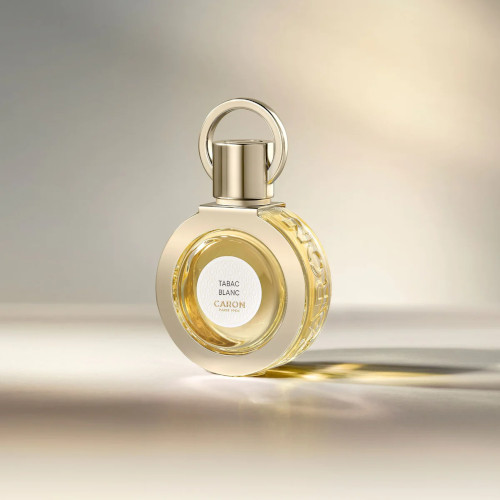
Oriza L. Legrand, Peau d’Espagne 1872
The historic house of Oriza L. Legrand has revived “a leather with powdery, woody notes” launched in 1872 in an updated version that retains a strong character: between old-fashioned soap and assertive animality, the fragrance feels like a play on the duality between clean and dirty.
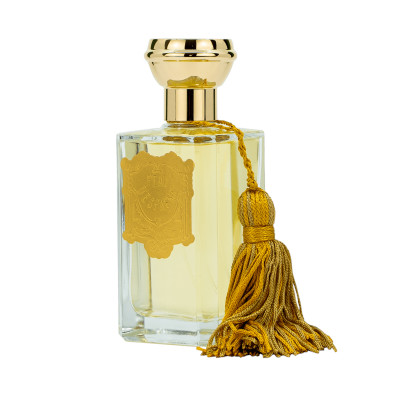
Memo, Iberian Leather
There are those who approach leather not as a trend but as a collection. This is the case with Memo, which launched Iberian Leather, the eleventh opus in its range of “nomadic leathers” as an invitation to travel. Described as “dense and smoky” by the brand, it features cedar in a bouquet of woody, spicy and vanilla flowers.
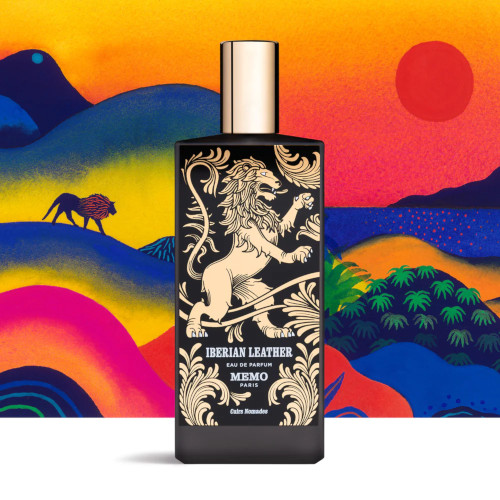
Atelier Materi, Cuir Nilam
Cuir Nilam is all about smoke, but it is a light smokiness, conjuring up a sensual leather that remains elegant. Céline Perdriel tells us: “I started working with Véronique Le Bihan three years ago. I found a common thread running through all of Atelier Materi’s creations: a hint of skin, a little Suederal. When she wanted patchouli leather to complete the range, she conjured up the image of a new biker’s jacket. I didn’t want to give it a dirty treatment. Besides, for me, leather is the stuff of ballet shoes: I’ve done a lot of dancing, of pointe work, it’s worse than Proust’s madeleine. I used different qualities of patchouli, including a fractioned one where the mouldy aspect is removed, which is fruitier and evokes chocolate. There are warm, slightly fur-like notes, with cistus and Suederal, which brings out a very leathery side, and IBQ. And the more vegetal facets to soften it: violet leaf, cardamom and a rosy note. The touch test doesn’t do it justice: the fragrance really comes into its own on the skin, and that’s how Véronique immediately tested it.”
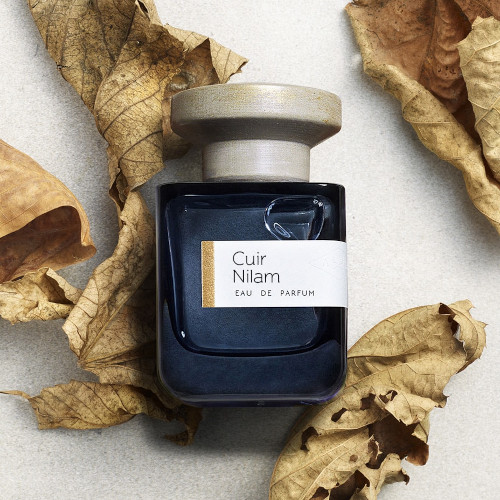
Jardins d’écrivains, Peau d’âne
Anaïs Biguine has taken animality a step further by imagining a “perfume the colour of time” for her Jardins d’écrivains brand, inspired by Charles Perrault’s fairy tale and its big screen incarnation. The result? A suede that, beneath its innocent exterior, quickly reveals animalic, fatty, powdery facets, lying between gustatory memories and big cats lurking in the shadows.
This perfume is part of the Box Auparfum – #36 – novembre/décembre 2022
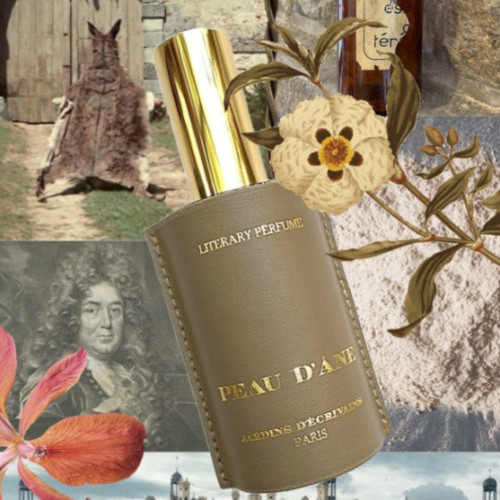
Marc-Antoine Barrois, Encelade
A love of ambivalence is also perceptible in Encelade by Marc-Antoine Barrois, a “fragrance of shadow and light that delights to play with its paradoxes.” The fresh green notes from “luxuriant nature” are intertwined with animal skin, smoky notes echoing the great green leathers of the past.
This perfume is part of the Box Auparfum – #33 – mai/juin 2022

D’Orsay, Dandy or not
At d’Orsay, duality takes the form of a contrast between “tangy nonchalance and calm elegance.” Sidonie Lancesseur combines the leather accord with notes of black tea and orange blossom to evoke “casual love.”
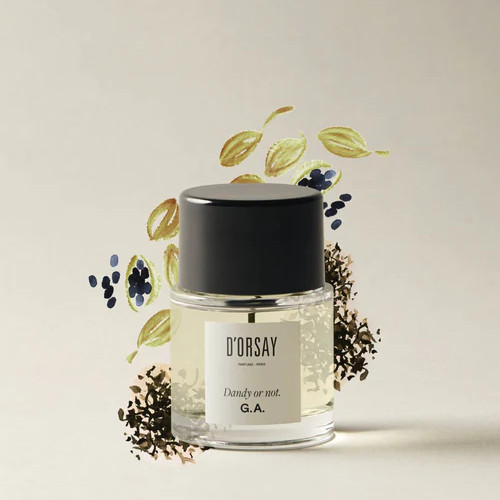
DS & Durga, Leatherize
Tea notes crop up again in a smoked version in Leatherize by DS & Durga: a lapsang souchong with phenolic and floral facets, described as “modern transparent leather that instantly amplifies another fragrance.”
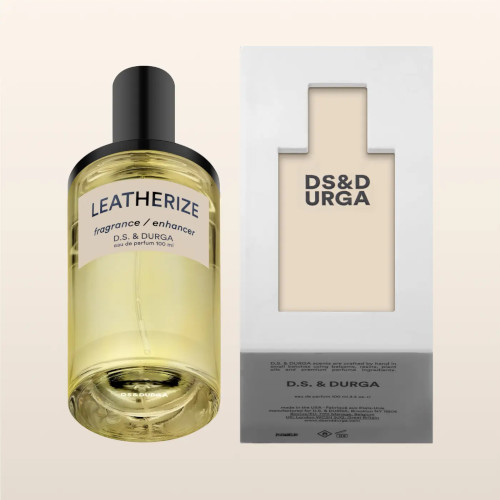
L’Atelier parfum, Leather Black K(night)
Leather Black K(night) by Serge de Oliveira for L’Atelier parfum is also about flowers, particularly jasmine, but also iris, which gives it an almost cosmetic opening segueing into an animalic feel that darkens to pay homage to leathery chypres.
This perfume is part of the Box Auparfum – #36 – novembre/décembre 2022
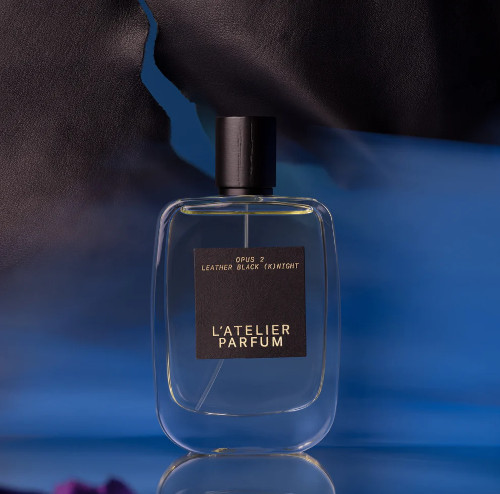
Régime des fleurs, Leather Petals
“What if flowers were made of leather?” is the question that guided Alia Raza, founder of the Régime des fleurs brand, with Leather Petals, her ode to New York. The tanned skin is adorned with a bouquet of osmanthus, davana, iris and patchouli on a woody, balsam base.
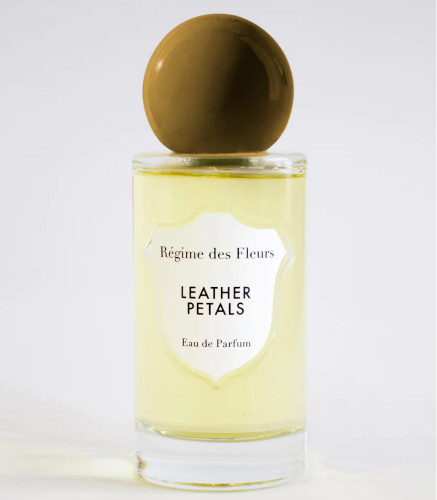
Hermès, Violette Volynka
When you work at Hermès, composing a leathery fragrance is both logical and challenging. With access to the Parisian house’s leather cellar, Christine Nagel can smell different qualities of skins, including the one that inspired her for the recent Violette Volynka: “When I came across Volynka leather, the emotional reaction was instantaneous. Without knowing when or what, I was immediately convinced that I would use it as the starting point for a creation. I was struck by the same bolt of lightning as when I discovered the softness and femininity of Doblis for Galop. The beauty of the material I was touching, the strength of its tortuous texture, almost like an olive tree trunk, conveyed the craftworker’s skill and mastery. Its aroma reflects the irregular, grained, thick, diamond-shaped leather. Its strength and power are hard to tame. I wanted to use a new accord to reinvent the peaty, woody, smoky notes of this sophisticated leather with its scent of burnt wood. I mastered the leather by working on its maturation and with meticulous maceration, making it soft and supple. I reworked the violet so it was stronger and could cohabit with the leather. A subtle, powdery violet that would soften the leather with its woody accents and force it to metamorphose.”
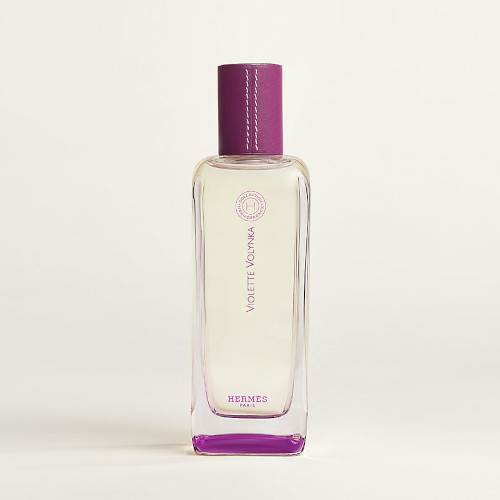
Goldfield & Banks, Purple Suede
Same colour, different flower: at Goldfield & Banks, lavender is at the heart of Purple Suede, more specifically, “the sunburnt lavender fields” that grow in Tasmania, intensified by a “leather marked by smoky woods.”
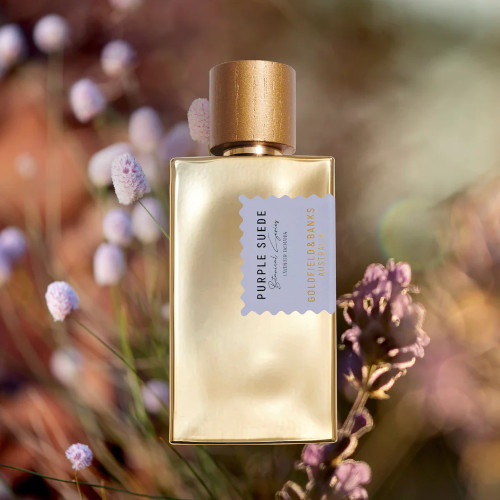
Astier de Villatte, Tucson
Astier de Villatte’s Tucson is a fiery interpretation of the accord, painting the contours of a “torrid desert of savage beauty” with immortelle, thyme and spices. Alexandra Monet worked on the leathery aspect with cistus and birch, producing a result that is both dry and syrupy.
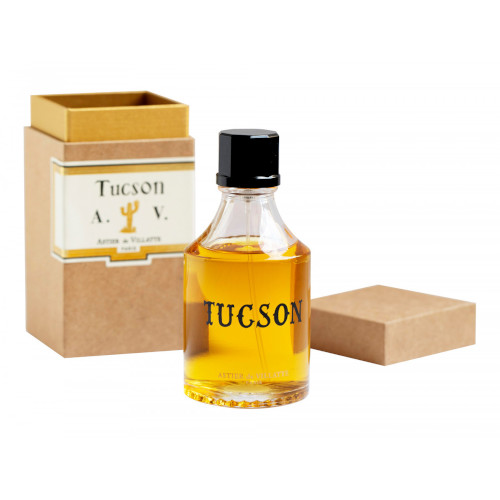
Eris, Scorpio Rising
With its “cocktail of overdosed spices” overlaying smoky woods and molten amber, Scorpio Rising is an impetuous leather fragrance by Antoine Lie, who was inspired by the astrological sign that gives the composition its name to create a fragrance that is “dangerous and addictive.”
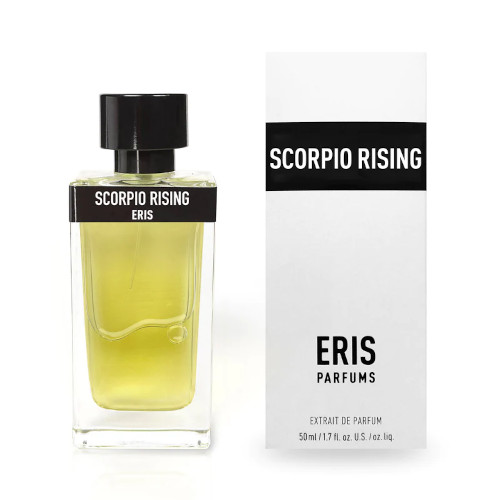
Thierry Blondeau, Cuir frappé
Would you like a little glass of leather? Thierry Blondeau’s Cuir Frappé, with its notes of wild strawberry, lemon and rhubarb, is evocative, like spicy chewing gum. Osmanthus sets the tone for this rather discreet leather accord.
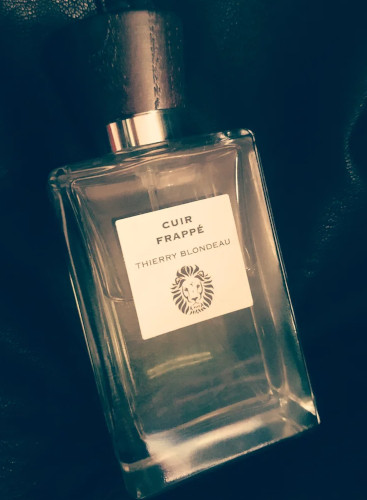
Scents of Wood, Leather in Armagnac
Scents of Wood also likes playing with alcohol, but in a completely different way: with Leather in Armagnac, perfumer Yves Cassar pays tribute to the French eau-de-vie, devising “a magnificent elixir of spices, wood and leather.”
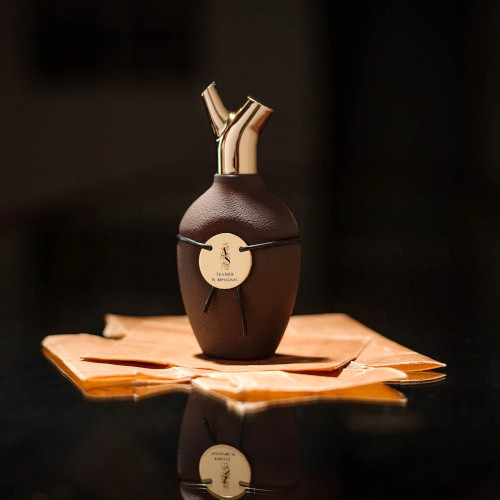
Olibanum, Cuir végétal
Let’s stay in the woods with Olibanum, which offers all kinds of variations on the resin, including Cuir végétal: described as “androgynous and monochrome”, it combines black oud, cumin and cedar.
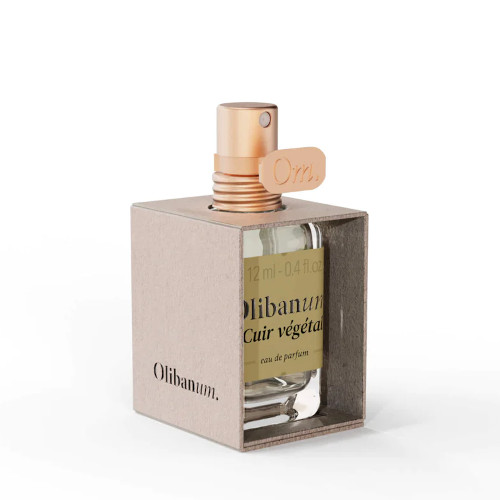
Obvious, Un Oud
Obvious highlights traditional oud from Aquilaria Crassna, which the brand gives voice to: “when attacked, I defend myself by secreting a resin that makes me rarer and more precious than gold.” The opening is fresh while the woody, balsam base remains soft.
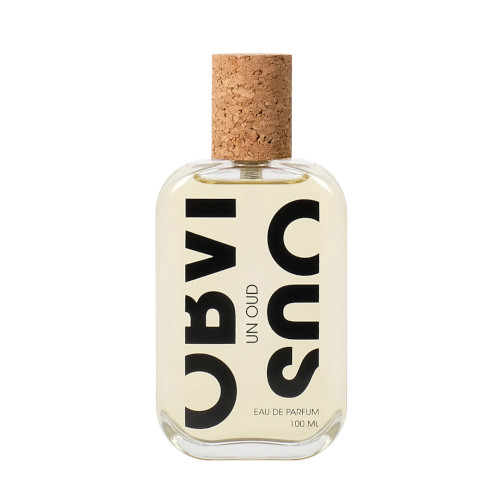
Une nuit nomade, Sugar Leather
The brand’s Une nuit à Oman collection is an invitation to take a journey to the desert on the back of a dromedary, its saddle “heated by an arrogant sun, giving off a sweet and delicate smell of leather.” Like a piece of leather caramelised by the sun, this spicy and liquorous delight created by Anne-Sophie Behaghel brings together cinnamon, plum, tonka, labdanum and patchouli in a rich and appetising composition.

And what about the future?
It’s a safe bet that leather in perfumery has a bright future ahead of it, on top of an already rich past: “Working with leather is a never-ending task and tremendously stimulating. In all my perfumes, I like to play with duality, to force nature, to coax or transform the raw material through unexpected combinations. I like to go against the grain and make the raw material say the opposite of what’s expected. This is absolutely true of leather,” says an enthusiastic Christine Nagel.
As for Céline Perdriel, she is already visualising “a masculine white flower with a leathery note. Or else leathery aromatic notes based on sagebrush or honeysuckle, for example, which were quite popular in the 1980s, but which could be reimagined in a more modern form.”
Notes
| ↑1 | See the article on this subject in Nez #15 – As time goes by. |
|---|---|
| ↑2 | Beyries S. 2008. “Modélisation du travail du cuir en ethnologie : proposition d’un système ouvert à l’archéologie [Modelling leatherworking in ethnology: proposal for a system open to archaeology]”, Anthropozoologica 43 (1) : 9-42. |
| ↑3 | Mathilde Cocoual, Aux sources des parfums. Industrialisation et approvisionnement de la parfumerie grassoise (milieu XIXe–milieu XXe siècle) [The source of perfumes. Industrialisation and sourcing of the perfume industry in Grasse (mid-19th to mid-20th century)], 2017 |
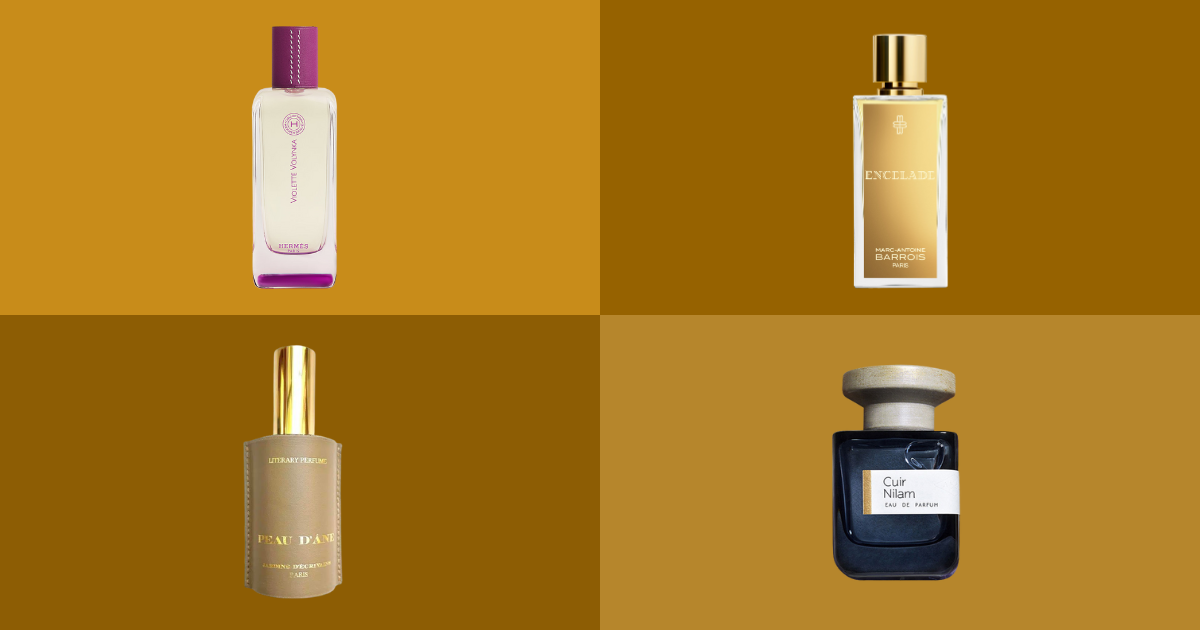







Comments